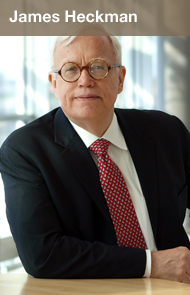
November 5-6, 2010
Organizers
- Bo Honoré, Princeton University
- Jeff Smith, University of Michigan
- Petra Todd, University of Pennsylvania
Edward Vytlacil, Yale University
James Heckman’s students and colleagues paid tribute to their “academic father” at a conference that reflected his wide-ranging influence on generations of scholars—and on important questions of human welfare.
“As a Heckman student, you feel like you’re part of unbroken line. You are mentored by older, more experienced students and you hear stories of previous students from the fabled past,” said conference co-organizer Edward Vytlacil, BA ’94, PhD ’00. “This conference is a chance for people who have known Jim Heckman across generations to meet and interact.”
Presentation topics varied widely, linked by a common thread: the application of econometric models and economic theory to understand how social policies and institutions affect individuals and outcomes. As Heckman put it in his closing talk, “By tackling questions this way, using economic theory and econometric practice, you can get more.”
Several presenters tackled a topic Heckman is well-known for: investing in education. Colleagues used Heckman's estimating techniques to explore how the timing of grade retention for young children affects their long-term outcomes—a significant question, since 10 percent of students will fail a grade by age 12. Other researchers looked at how shocks and shifts in parental income at different periods throughout childhood influenced a family’s investment in their children’s human capital, as measured by college attendance and the relationship between wage bargaining power and the decision to pursue schooling. Another study presented found that incentive schemes that reward both students and teachers improved math learning more than bonuses for just students or teachers.
Other research presented examined the economic decisions of adults to understand the career choices and compensation of executives, patterns in demand for social welfare programs, and physician pay-for-performance schemes.
On the macroeconomic side, Marcelo Dabós of Universidad De Belgrano applied new methodology to demonstrate that a nation’s degree offinancial development is not significantly linked to its economic growth, regardless of the country’s development level or its authoritarian or democratic orientation. Ricardo Barros of IPEA identified government transfers, minimum wage increases, and rapid expansion of education as the key factors in Brazil’s remarkable reduction in poverty and income inequality since 2007, but noted that there’s plenty of room for improvement through more efficient policies
For the closing presentation, Heckman chose to present ongoing work that many of his students and colleagues had heard of, collaborated on, or built upon in their own work. His talk explored a model that offers a more powerful way to measure the marginal costs and benefits of social programs.
Estimating such returns can be complicated the effect of a policy differs among individuals, and they know and act on their expected returns. Heckman addressed those challenges with a framework for determining the marginal treatment effect for a given policy. He showed how it could be applied to identify the returns to education.
The framework draws on choice theory to identify an individual’s private costs of pursuing education, and accounts for different levels of knowledge about the costs and benefits of that choice. The marginal treatment effect is “empirically attractive and very useful,” Heckman told the audience. It can be used to reveal the return (in wages) for people who go to college and those who don’t.”
Using this approach, it is possible to estimate the Policy Relevant Treatment Effect (PRTE) to analyze the impact of a change in policy that influences schooling choice. Marginal PRTE is appropriate parameter with which to conduct policy analysis, Heckman noted.

